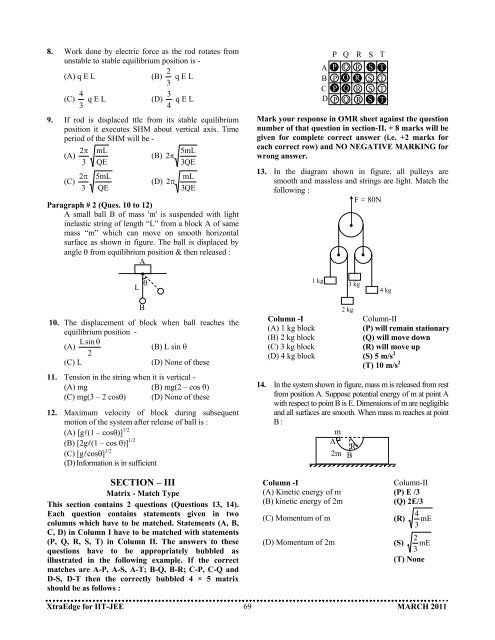March 2011 - Career Point
March 2011 - Career Point
March 2011 - Career Point
Create successful ePaper yourself
Turn your PDF publications into a flip-book with our unique Google optimized e-Paper software.
8. Work done by electric force as the rod rotates from<br />
unstable to stable equilibrium position is -<br />
(A) q E L<br />
(C) 3<br />
4 q E L<br />
(B) 3<br />
2 q E L<br />
(D)<br />
4<br />
3 q E L<br />
9. If rod is displaced ttle from its stable equilibrium<br />
position it executes SHM about vertical axis. Time<br />
period of the SHM will be -<br />
(A)<br />
(C)<br />
2π<br />
3<br />
2π<br />
3<br />
mL<br />
QE<br />
5mL<br />
QE<br />
(B) 2π<br />
(D) 2π<br />
5mL<br />
3QE<br />
mL<br />
3QE<br />
Paragraph # 2 (Ques. 10 to 12)<br />
A small ball B of mass 'm' is suspended with light<br />
inelastic string of length “L” from a block A of same<br />
mass “m” which can move on smooth horizontal<br />
surface as shown in figure. The ball is displaced by<br />
angle θ from equilibrium position & then released :<br />
A<br />
A<br />
B<br />
C<br />
D<br />
P Q R S T<br />
P Q R S T<br />
P Q R S T<br />
P Q R S T<br />
P Q R S T<br />
Mark your response in OMR sheet against the question<br />
number of that question in section-II. + 8 marks will be<br />
given for complete correct answer (i.e. +2 marks for<br />
each correct row) and NO NEGATIVE MARKING for<br />
wrong answer.<br />
13. In the diagram shown in figure, all pulleys are<br />
smooth and massless and strings are light. Match the<br />
following :<br />
F = 80N<br />
L θ<br />
1 kg<br />
3 kg<br />
4 kg<br />
B<br />
10. The displacement of block when ball reaches the<br />
equilibrium position -<br />
Lsin<br />
θ<br />
(A)<br />
(B) L sin θ<br />
2<br />
(C) L<br />
(D) None of these<br />
11. Tension in the string when it is vertical -<br />
(A) mg (B) mg(2 – cos θ)<br />
(C) mg(3 – 2 cosθ) (D) None of these<br />
12. Maximum velocity of block during subsequent<br />
motion of the system after release of ball is :<br />
(A) [gl(1 – cosθ)] 1/2<br />
(B) [2gl(1 – cos θ)] 1/2<br />
(C) [glcosθ] 1/2<br />
(D) Information is in sufficient<br />
SECTION – III<br />
Matrix - Match Type<br />
This section contains 2 questions (Questions 13, 14).<br />
Each question contains statements given in two<br />
columns which have to be matched. Statements (A, B,<br />
C, D) in Column I have to be matched with statements<br />
(P, Q, R, S, T) in Column II. The answers to these<br />
questions have to be appropriately bubbled as<br />
illustrated in the following example. If the correct<br />
matches are A-P, A-S, A-T; B-Q, B-R; C-P, C-Q and<br />
D-S, D-T then the correctly bubbled 4 × 5 matrix<br />
should be as follows :<br />
2 kg<br />
Column -I<br />
Column-II<br />
(A) 1 kg block<br />
(P) will remain stationary<br />
(B) 2 kg block<br />
(Q) will move down<br />
(C) 3 kg block<br />
(R) will move up<br />
(D) 4 kg block (S) 5 m/s 2<br />
(T) 10 m/s 2<br />
14. In the system shown in figure, mass m is released from rest<br />
from position A. Suppose potential energy of m at point A<br />
with respect to point B is E. Dimensions of m are negligible<br />
and all surfaces are smooth. When mass m reaches at point<br />
B :<br />
m<br />
A<br />
R<br />
2m B<br />
Column -I<br />
Column-II<br />
(A) Kinetic energy of m (P) E /3<br />
(B) kinetic energy of 2m (Q) 2E/3<br />
(C) Momentum of m (R)<br />
4<br />
mE<br />
3<br />
2<br />
(D) Momentum of 2m (S) mE<br />
3<br />
(T) None<br />
XtraEdge for IIT-JEE 69<br />
MARCH <strong>2011</strong>

















